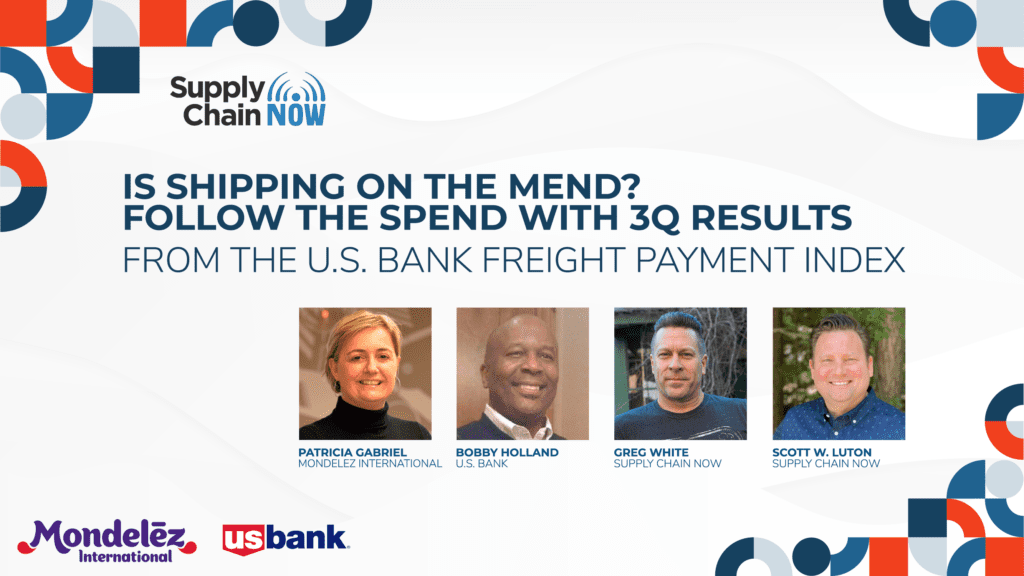
Supply Chain Now’s Guide to Resilience in the Supply Chain
The resiliency of the supply chain has been tested time and time again — strained by weather-related events like hurricanes, global crises such as COVID-19, disasters like the Francis Scott Key Bridge collapse, and security breaches from cyberattacks.
Supply chain resilience will continue to be tested. In fact, a major supply chain crisis could be just days away as the International Longshoremen’s Association (ILA) could stage a strike at ports all along the East and Gulf coasts of the United States as soon as Oct. 1.
Beyond the Buzz: What is Supply Chain Resilience?
“Supply chain resilience refers to the ability of a supply chain to prepare for unexpected events, adapt to disruptions, and recover quickly to restore its normal service levels,” Inbound Logistics said. “It’s not merely about preventing disruptions but being able to turn challenges into opportunities for growth and improvement.”
Supply Chain Dive said because of events like COVID-19, the Panama drought, and Houthi attacks in the Red Sea, supply chain disruptions have become “part of the public’s consciousness and everyday nomenclature.”
“The risk in our global economy is that supply chain disruptions are guaranteed to continue, but no forecast exists to tell us when or how they will transpire,” it said.
The Need for Supply Chain Resilience: Three Threats to the Supply Chain in 2024
Threats to the supply chain are many, but here are just a handful of issues to keep an eye on this year:
1. Labor Challenges
- Workforce Shortages
In trucking alone, there is an estimated shortage of 60,000 drivers, which the Commercial Carrier Journal said has “profound implications on the supply chain, affecting everything from the availability of everyday consumer goods to the stability of national economic growth.”
- Strikes and Labor Disputes
If the ILA goes on strike, trade at ports on the East and Gulf coasts essentially will come to a standstill. “Even a two-week strike could disrupt supply chains until 2025,” an associate U.S. economist with Oxford Economics said in a report.
- Skill Gaps and Training Needs
Reskilling supply chain workers is a top priority for companies as a result of lessons learned during the pandemic, according to an EY report. It said there will be “efforts to help workers use digital technologies, adapt to changing company strategies and ways of working like increased virtual collaboration, and assist people in operating equipment with health and safety in mind.”
Inbound Logistics pointed out that “well-trained employees are key to a resilient supply chain. Regular training programs on the latest supply chain management tools and risk management practices empower employees to handle disruptions proactively.”
2. Geopolitical Tensions
- Trade Policies and Tariffs
Examples making headlines include:
- The Biden administration is pushing to prevent the Chinese e-commerce platforms Shein and Temu from the use of de minimis, which exempts shipments of less than $800 from import duties and taxes.
- Former President Donald Trump has vowed that if reelected, he will levy a 60% tariff on imports from China and a 10% on goods from other countries. CNN cited economists who warned the tariffs could set off a global trade war – and disrupt the supply chain.
- Political Instability
Political unrest around the world impacts the supply chain. That includes the ongoing conflict that has followed the Oct. 7, 2023, attack on Israel by Hamas.
“Houthi attacks against commercial ships in the Red Sea have upended global shipping,” the Council on Foreign Relations said. Diverting cargo ships to safer routes has impacted about 40% of the Asia-Europe trade that normally transits the Red Sea.
- Sanctions and Export Controls
Sanctions, “including blocking off assets and trade, are made for reasons other than business, such as foreign policy or national security,” USA Facts said. “This makes sanctions distinct from trade tariffs directed at specific countries or regions.”
Most sanctions programs involve specific nations such as Russia, Cuba, North Korea, and Iran. U.S. companies can be fined for violating the rules of the sanctions program.
The Office of Foreign Assets Control maintains a Sanctions List Service with frequent updates of trade sanctions. It’s a valuable tool for businesses involved in international trade.
3. Extreme Events
- Hurricanes, Blizzards, Droughts …
The National Oceanic and Atmospheric Administration still forecasts “an extremely active hurricane season that could rank among the busiest on record.” Already the supply chain has been impacted in 2024 by Hurricanes Beryl and Debby.
- Cyberattacks
Logistics is the second most targeted industry by cybercriminals, according to Hornet Security
“Supply chain disruptions can take on an infinite number of permutations,” Supply Chain Dive said. “However, one of the most plausible and existential threats to the U.S. economy is a cybersecurity attack on our national infrastructure.”
For example, the 2020 SolarWinds cyberattack, which exposed the data of thousands of private companies and government agencies in the United States and Europe, has been called one of the most sophisticated supply chain breaches. The malware involved in the attack infected software that was used to manage affected organizations’ networks and enabled access to their systems.
- Infrastructure Destruction
The late-March collapse of the Key Bridge was a historic case of infrastructure damage and one that forced the diversion of container ships bound for the Port of Baltimore for nearly three months while the main shipping channel was closed.
- Global Health Crises
COVID-19 arguably created the most disruptive supply chain crisis. Ports shut down, crew members were stuck on ships for months, and then, when trade resumed, gateways were overwhelmed by the volume of goods coming in.
5 Steps to a Resilient Supply Chain
Supply chain disruptions will happen; it’s just a matter of when, where, and what type of event will occur. You can’t just sit back and wait. Supply chain stakeholders must prepare for whatever may come.
1. Risk Assessment and Management
“Disruptions are a fact of life, whether natural disasters, pandemics, or economic shifts,” Inbound Logistics said. “A resilient supply chain proactively identifies potential risks and plans mitigation strategies. This preparedness minimizes the impact of disruptions and allows for a quicker recovery.”
2. Diversification of Supply Sources
“Diversified sourcing plays a pivotal role in building a resilient supply chain. By retaining multiple supply locations and engaging with domestic and international suppliers, companies minimize the risk of disruptions caused by geopolitical issues, natural disasters, or supplier-specific problems,” Inbound Logistics said.
3. Leveraging Technology
“A resilient supply chain integrates robust data analytics, agile methodologies, and flexible network designs to respond dynamically to changing conditions. It uses advanced technologies like artificial intelligence and digital twins to predict disruptions and automate responses,” Inbound Logistics said.
An EY report on the impacts of COVID-19 on the supply chain noted that “some positives” did come out of the disruption caused by the pandemic.
“For example, supply chain finally got a voice, and much-needed investment in technical capabilities such as real-time visibility and resilience,” the report said. “The pandemic also forced supply chains to develop new agility to carry forward – for example, many organizations are building advanced analytics to do dynamic SKU rationalization rather than doing one-off spreadsheet exercises when inventory gets too high, or the next crisis requires optimization. And as a result, a high-performing supply chain is now perceived as a competitive necessity.”
4. Developing Contingency Plans
“For each potential disaster category or scenario, such as a natural disaster or a cyberterrorism event, the disaster recovery plan should include preparation and prevention requirements, employee roles and responsibilities, response methodology and approach, and a contact list and notification hierarchy,” Supply Chain Dive said.
5. Building Strong Relationships
Investments in supply chain resilience are more important than ever, as is collaboration among stakeholders, according to an S&P Global Market Intelligence Outlook.
“Spending on supply chain visibility technology is increasing, though third-party support is increasingly needed,” it said.
Stay Informed with Supply Chain Now
“Resilience is more than a defensive measure – it’s a proactive stance that enables companies to adapt swiftly and effectively to unexpected challenges,” Inbound Logistics said.
A proactive stance includes talking about how to respond to unexpected challenges to maintain a resilient supply chain. That’s where Supply Chain Now comes in.
Supply Chain Now is the authority in supply chain podcasts, providing listeners with valuable insights into current disruptive events as well as threats on the horizon.
Our library is packed with podcasts addressing supply chain resiliency, including:
- “2024 Disruption: Port Challenges, Drayage Shipping & Planning Ahead,” featuring Nathan Crocker and Drew Herpich of Nolan Transportation Group.
- “3 Ways to Grow a More Sustainable, Resilient Supply Chain,” with Stephanie Richelieu Stagger of 3G.
- “Why You Must Deliver: Bending to Economic Inversions and Withstanding Supply Chain Tech Disruption,” with Supply Chain Now founder and CEO Scott W. Luton and podcast host Greg White.
Supply Chain Now brings everything you need to know about supply chain disruptions and resiliency to one place, with podcasts, livestreams, vlogs, virtual events, and written articles.
Our programs include:
- The flagship Supply Chain Now podcast.
- The Logistics with Purpose series spotlights organizations around the globe that are making a positive impact.
- Digital Transformers, hosted by thought leader Kevin L. Jackson.
We’ll continue talking about supply chain resiliency and all the threats and disruptions the industry faces. Listen now.
More Articles

Is Shipping on the Mend? Follow the Spend with 3Q Results from the U.S. Bank Freight Payment Index

